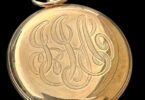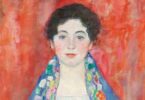Razmig Bedirian
Louvre Abu Dhabi has revealed a new acquisition – an artwork by Jean-Honore Fragonard that exemplifies his influence on 18th-century French painting.
Les Marionnettes was officially hung in the museum’s third wing, which, in an ongoing rotation process, now focuses on the time period of the French Revolution, juxtaposing official portraits with more personal scenes.
The artwork, painted in 1770, depicts a garden on the western outskirts of Paris, where a puppeteer performs to a crowd spread across social classes. While nobility are seated on the right side of the podium, those from other strata of society throng in front of it, fervently watching the puppeteer perform. Others are buying goods a stone’s throw from the event. Sunlight streams in from between the trees, exhibiting Fragonard’s fluency in light and shadow. A solitary statue, meanwhile, observes the scene through a thicket.
Les Marionnettes is replete with motion, excitement and mystery – given the distance of its vantage point and the rosebushes that conceal the viewer from the scene. There are also events unfolding in the margins and between the festive scene, including a couple embracing in the hedge behind the puppeteer.
The painting is being exhibited near a previous Louvre Abu Dhabi acquisition of another of Fragonard’s works, The Bolt. Smaller in size than Les Marionnettes, the painting shows a couple as they bolt shut a bedroom door in a bid for privacy. The Bolt also displays Fragonard’s mastery of light, this time presenting the scene with a theatrical contrast.
As such, there is a significant difference in style, theme and approach between the two paintings.
:quality(70)/cloudfront-eu-central-1.images.arcpublishing.com/thenational/3WOQCJXC65GHZG3DOFXPDDXGHQ.jpg)
Guilhem Andre, chief curator at Louvre Abu Dhabi, says Les Marionnettes was specifically acquired because it shows a different aspect of Fragonard. The acquisition comes as part of the museum’s mission to present more varied works by artists to give visitors a wider scope of their individual output.
“Fragonard painted in different styles during his life,” Andre says. “He’s not a very easy painter to understand. He shifted from historical paintings to landscapes, mythology and portraits. He did a little bit of everything.”
Paintings such as Les Marionnettes, which depict a cultural scene, were among the most sought after, Andre says. Puppet shows were a popular pastime in 18th-century France, and Fragonard’s depiction is a dynamic study of the social setting.
“This one is between a landscape and a social painting,” he says. “The garden has been identified. It was a private one and would be open to the public three Sundays a month. Many artists were coming to this garden, training and studying painting. There would also be small booths and shops there, which we see in the painting.”
Les Marionnettes has an important place in the timeline of Fragonard’s career. It is thought to have come as a precursor to one of his most highly regarded works, La Fete a Saint-Cloud, which now hangs at the Banque de France and depicts a scene similar to Les Marionnettes.
“This one is probably a previous state of the idea that became that larger painting,” Andre says. “But it’s a finished painting. The larger one is diluted a little bit with some characters at the bottom but a very high sky. This is not the case here. It’s focused.
“You see the light is giving the impression of depth,” he says. “Some groups of people are darker in the foreground, and the background is more lit. Nature is also very important and key to understanding this type of work from Fragonard. Nature is very dense, very rich, and it’s a beautiful aspect of the painting.”
Les Marionnettes is also significant for its rarity. While Fragonard painted hundreds of works across his career, it is difficult to come by a painting that has not already been inducted into an institution’s collection. Louvre Abu Dhabi acquired the piece from the family who owned the work for almost a century. It was previously owned by two other families.
“We already had a painting by Fragonard,” Andre says. “But … we were looking for something outstanding and had the opportunity to find it.”
Courtesy: thenationalnews







